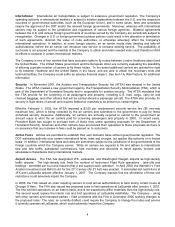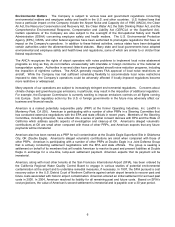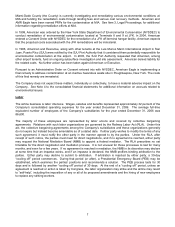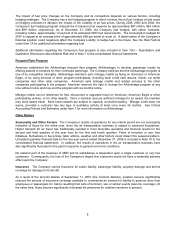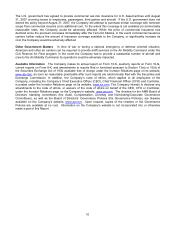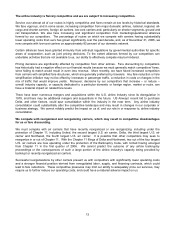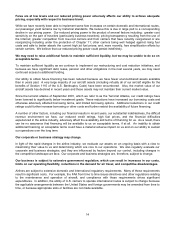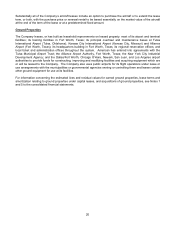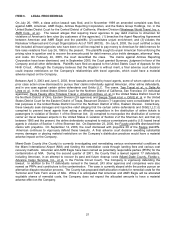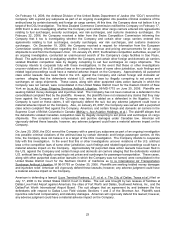American Airlines 2006 Annual Report Download - page 18
Download and view the complete annual report
Please find page 18 of the 2006 American Airlines annual report below. You can navigate through the pages in the report by either clicking on the pages listed below, or by using the keyword search tool below to find specific information within the annual report.14
Fares are at low levels and our reduced pricing power adversely affects our ability to achieve adequate
pricing, especially with respect to business travel.
While we have recently been able to implement some fare increases on certain domestic and international routes,
our passenger yield remains low by historical standards. We believe this is due in large part to a corresponding
decline in our pricing power. Our reduced pricing power is the product of several factors including: greater cost
sensitivity on the part of travelers (particularly business travelers); pricing transparency resulting from the use of
the Internet; greater competition from low-cost carriers and from carriers that have recently reorganized or are
reorganizing including under the protection of Chapter 11; other carriers being well hedged against rising fuel
costs and able to better absorb the current high jet fuel prices; and, more recently, fare simplification efforts by
certain carriers. We believe that our reduced pricing power could persist indefinitely.
We may need to raise additional funds to maintain sufficient liquidity, but we may be unable to do so on
acceptable terms.
To maintain sufficient liquidity as we continue to implement our restructuring and cost reduction initiatives, and
because we have significant debt, lease, pension and other obligations in the next several years, we may need
continued access to additional funding.
Our ability to obtain future financing has been reduced because we have fewer unencumbered assets available
than in years past. A very large majority of our aircraft assets (including virtually all of our aircraft eligible for the
benefits of Section 1110 of the U.S. Bankruptcy Code) have been encumbered. Also, the market value of our
aircraft assets has declined in recent years and those assets may not maintain their current market value.
Since the terrorist attacks of September 2001, which we refer to as the Terrorist Attacks, our credit ratings have
been lowered to significantly below investment grade. These reductions have increased our borrowing costs and
otherwise adversely affected borrowing terms, and limited borrowing options. Additional reductions in our credit
ratings could further increase borrowing or other costs and further restrict the availability of future financing.
A number of other factors, including our financial results in recent years, our substantial indebtedness, the difficult
revenue environment we face, our reduced credit ratings, high fuel prices, and the financial difficulties
experienced in the airline industry, adversely affect the availability and terms of financing for us. As a result, there
can be no assurance that financing will be available to us on acceptable terms, if at all. An inability to obtain
additional financing on acceptable terms could have a material adverse impact on us and on our ability to sustain
our operations over the long term.
Our corporate or business strategy may change.
In light of the rapid changes in the airline industry, we evaluate our assets on an ongoing basis with a view to
maximizing their value to us and determining which are core to our operations. We also regularly evaluate our
corporate and business strategies, and they are influenced by factors beyond our control, including changes in
the competitive landscape we face. Our corporate and business strategies are, therefore, subject to change.
Our business is subject to extensive government regulation, which can result in increases in our costs,
limits on our operating flexibility, reductions in the demand for air travel, and competitive disadvantages.
Airlines are subject to extensive domestic and international regulatory requirements. Many of these requirements
result in significant costs. For example, the FAA from time to time issues directives and other regulations relating
to the maintenance and operation of aircraft, and compliance with those requirements drives significant
expenditures. In addition, the ability of U.S. carriers to operate international routes is subject to change because
the applicable arrangements between the United States and foreign governments may be amended from time to
time, or because appropriate slots or facilities are not made available.


